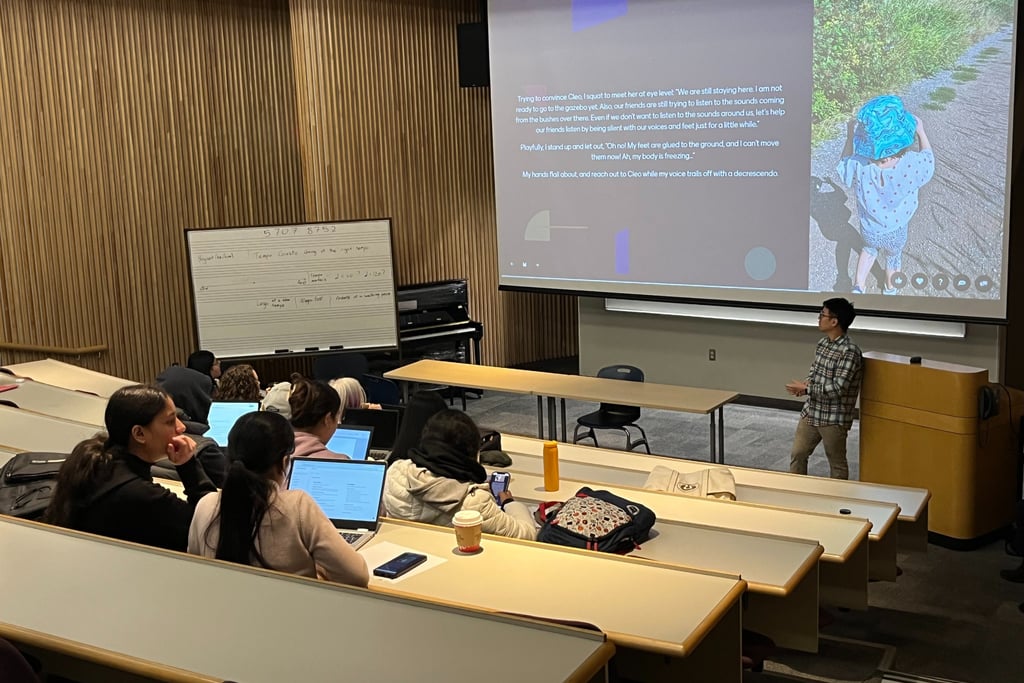Click here visit our Research-supported educational program for children
Tempo Giusto
ARTICLE
Bryant Goh
2/20/202511 min read
"Tempo Giusto" is a term often used to direct musicians to play at the ideal tempo or pace. But how do musicians determine what this ideal tempo is when the concept itself is abstract and lacks a definitive marker?
I became acquainted with the idea of tempo giusto through Clark (2003), who quoted Honore: “The Slow Movement is not about doing everything at a snail’s pace. Nor is it a Luddite attempt to drag the whole planet back to a pre-industrial utopia… the Slow philosophy can be summed up in a single word: balance. Be fast when it makes sense to be fast and slow when slowness is called for. Seek to live at what musicians call the tempo giusto – the right speed” (p. 8).
This article extrapolates the idea of tempo giusto to the daily lived experiences of human beings. What does it mean to approach our day-to-day lives with tempo giusto? How do we find the ideal pace for our activities, whether it be relaxing, working, playing, eating, or drinking?


My Relationship with Time
Coming from Singapore, a bustling metropolitan city-state, I always believed that speed was synonymous with productivity and efficiency. Compulsory military training further reinforced this belief, equating quickness with effectiveness. I learned to walk briskly on busy streets to avoid a prompt “tsk” from those behind me, to act swiftly during military drills to avoid penalties, and to ensure that I met others' expectations without delay.
As an Early Childhood Educator, I often felt conflicted about my relationship with time. Society’s expectations clashed with my desire for young children to engage deeply in their work without feeling rushed. Reflecting on my early teaching years, I realized that hurrying children to pack up, finish activities, or walk briskly instilled an unconscious habit of haste. This habit led to hasty decisions, increased risk of injury, and a lack of analytical depth in their tasks. Rushing diminishes the time available for thoughtful reactions and thorough thinking.
Pursuing a Master’s degree at the University of British Columbia in Vancouver, BC, opened my eyes to how people embody time differently. While some hurried, adhering to the notion that “Time waits for no one. Time is money.” I also witnessed many others savouring their moments—taking leisurely lunch breaks, reading in the sun, or simply enjoying a quiet reprieve.
My sister, who had lived in the States for several years, commented on my tendency to overpack my schedule with activities. She said, “It’s a very Singaporean, and probably Asian, thing to try to seize the day by piling up tons of activities or appointments. Why do you want to feel rushed all day? Does it make you feel satisfied?”
Her words struck a chord. While I admired those who had a slower relationship with time in Vancouver, I realized I had not made similar adjustments for myself. My academic life, ironically, paced me at a rushed speed, reminiscent of my life in Singapore. I was living on others' terms, not engaging with my environment on my own temporal terms.
My sister’s insight inspired me to reevaluate my relationship with time. Instead of zealously overplanning my days, I made realistic schedules, that allowing for a more measured pace.
The key lesson was to avoid overplanning and striking a balance between being too hasty or slow, embodying the essence of tempo giusto—going at an ideal pace. I gradually adopted a realistic routine plan in the following months and avoid unachievable goals. However, when I began working at a private education center, I found myself slipping back into old habits of rushing and overplanning due to a work culture that prioritized quick results. This "Time is Money" mentality created an unwholesome environment that neglected the importance of taking time.
The loss of relationships due to my rushed lifestyle was a wake-up call to leave the workplace that exacerbated a work culture and lifestyle of hastiness. It was a turning point, shaking me into realizing that I needed to change my approach to time and start living well with myself.
During the Summer of 2024, whilst I co-facilitated outdoor summer camps for young children, I learned many valuable lessons about the relationship of time from the children, my coworkers and even a squirrel at Terra Nova Rural Park.
Lessons Learned from the Children
Children often serve as mirrors, reflecting the behaviours and attitudes of those they spend significant time with. Observing children offers a unique glimpse into my relationship with time. Watching them rush from one activity to another reflected my rushed and anxious teaching style, which prompted me to reflect on my relationship with time. If I wish for the children to slow down and savour their moments, I must embody this practice myself rather than merely offering verbal reminders.
There were also beautiful moments when the children took my reminder to take time and showed it by becoming wholly absorbed in their activities. Take, for instance, their fascination with the community garden’s sprinklers at Terra Nova Rural Park. They were captivated by how the activated sprinklers worked and embarked on an investigation, oblivious to the possibility of getting soaked. They revelled in the sensation of water against their skin, fully owning their time and place, eager to experience it to the fullest. In those moments of deep engagement, I found myself trying to rush them, urging them to move on to the next item on my teaching plan.
Throughout my journey, I’ve had numerous moments where I had to resist the urge to interrupt or rush the children's experience. Genuine empathy in the realm of children's learning flourishes when educators transcend their own teaching perspectives. By shifting from a mindset of delivering knowledge to one of understanding how learning unfolds, teachers witness the magic of children making sense of the world around them. In this patient observation, we recognize the profound truth: learning is a process that unfolds over time. When we honour this process, we empower children to explore, question, and, ultimately discover their environment's wonders.
Lessons Learned from My Coworkers
Teachers, educators, and camp facilitators are human, just like those in any other profession. We all need breaks to recharge our energy and attention after spending time on a task. Only we know best how to rejuvenate ourselves.
In the case of my coworker who co-facilitated the summer camp with me, the car became her sanctuary—a bubble of isolation where she could recharge. My coworker understood the importance of taking time for herself. Sometimes, going at the right pace also means recognizing the need for a fermata (a musical term for a pause). We can alleviate frustrations that might otherwise cause an impasse by pausing to decompress, refocus, and recenter.
Witnessing my coworker model her recharging strategy, other children began to adopt similar practices. They requested short breaks in the car or chose to lie in the sunshade tent. Whenever the children appeared exhausted, my coworkers and I gave them the space to take the time they needed to decompress, refocus, recharge, and rejoin the activity. In doing so, we acknowledged the children’s ability to recognize when they felt tapped out and their need for a break.
One’s relationship with time doesn’t necessarily need to be constantly moving. We don’t have to go hastily, go at the right pace or slow down all the time. A valuable lesson from my coworker was that taking a break and pausing time play a part in helping one develop a healthy relationship with time. Recognizing and honouring the need for breaks is essential for well-being. Allowing ourselves and others the time to pause and recharge promotes a healthier and more balanced approach to tasks and activities.
Lesson Learned from the Squirrel
While searching for a shady area to sit and have lunch with the children and my coworker, we came across a squirrel that had positioned itself a little off-center on a wooden bridge at Terra Nova Rural Park, basking in the sun's rays. We paused to admire the squirrel’s ability to claim its time and space on the bridge, simply being present in the moment.
My coworker remarked that we could learn a valuable lesson from the squirrel—to just be. In a world that often demands constant movement and productivity, the squirrel’s observed serene presence serves as a reminder of the importance of taking time to pause and appreciate our surroundings. The squirrel wasn’t concerned with rushing to the next task or meeting anyone's expectations. It was content in its chosen spot, soaking up the warmth of the sun.
The lessons written above are great anecdotes that encourage us to reflect on our own lives and the value of finding moments of stillness. Just as the squirrel embraced its time in the sun, we too can benefit from carving out time to simply be—whether it’s taking a moment to breathe, enjoy a quiet break, or observe the beauty around us. Embracing these pauses can help us recharge and find a sense of peace amidst the hustle and bustle of daily life.
Below is an autoethnography titled ‘Tempo Giusto: Going at the right tempo.’ The writing encapsulates some of the lessons learned from the anecdotes written above:
Tempo Giusto: Going at the right tempo
Time. Hurry up!
Chronos. Stop wasting time!
Temporal space. Quit dilly-dallying!
Perhaps, to many, time is only seen as properly utilized when we avoid appearing unproductive or unpresentable—when we spare others from having to give us unwanted attention. We hurry through a meal, risking choking, or losing hours in the depths of social media, scrolling aimlessly.
In a world shaped by a neoliberal mindset, time is often reduced to a resource that demands constant productivity—a commodity we must not waste.
Time is a fascinating concept, experienced and measured differently depending on the lens through which we view it, such as time through history or time being measured accurately through the International System of Units (Clark, 2023, p. 11).
The utilization of time and how fast or slow time is experienced depends on us, the time users. How much effort do we put into guarding our chronos from becoming contaminated by neoliberal mindsets?
Do we perhaps view 24 hours in a day as plenty enough to senselessly; without batting an eyelid, wild it away to the whims and fast pace of what modern day demands of us? As adults seen as capable time users, how do we embody this understanding in our interactions with younger humans? How do we teach or guide children to navigate a world where time is often viewed through a neoliberal lens?
We often go from ‘using’ time to simply being in it. What would it look like to immerse ourselves in the moment, as opposed to constantly measuring each second for efficiency?
In moments unrushed, time sheds its weight,
Revealing a pace where stillness waits.
Beyond the clocks and endless demands,
A world unfolds in unhurried hands.
Here, presence breathes, unmeasured and free—
Time as it’s meant, not used, but to be.
This brings us to a day in Terra Nova Rural Park. Walking down the dirt path in Terra Nova Rural Park, Richmond, BC, I (Teacher Ben) am with three children and two co-workers. I am leading an activity with the children to engage them in listening and taking note of the sonic environment in Terra Nova Rural Park.
“Take your time. We are just walking quietly and listening to natural sounds around us,” I reply reactively to almost-turning four-year-old Cleo, who was tugging at my arm, suggesting we move along.
Cleo stopped tugging and just waited around instead of engaging in the activity of listening to natural sounds around.
“So, Cleo, we are not rushing to get anywhere. Stay around here a little bit. Oh! I heard something from somewhere over there! Shhh!” I added while gesturing at Cleo to freeze momentarily to pay attention to the sonic environment.
The rustling leaves and distant chirps of birds provided a gentle soundtrack to their surroundings, yet Cleo's impatience interrupted the stillness, “I don’t hear anything! There’s nothing there.”
“Really?” I ask.
“There’s nothing. Let’s go!” Cleo holds my hand and continues tugging, pulling me forward to reach the final destination, which was the raised platform gazebo that was way yonder.
In moments unrushed, time sheds its weight,
Revealing a pace where stillness waits.
Trying to convince Cleo, I squat to meet her at eye level: “We are still staying here. I am not ready to go to the gazebo yet. Also, our friends are still trying to listen to the sounds coming from the bushes over there. Even if we don’t want to listen to the sounds around us, let’s help our friends listen by being silent with our voices and feet just for a little while.”
Playfully, I stand up and let out, “Oh no! My feet are glued to the ground, and I can’t move them now! Ah, my body is freezing…
My hands flail about, and reach out to Cleo while my voice trails off with a decrescendo. Decisively, I come to a halt. A fermata, a break, a momentary pause. This was my final dramatic act. My feet rooted firmly on the ground, one hand cupping my ear, the other reaching out, frozen in time beneath the sun’s warm rays poking through the clouds.
Beyond the clocks and endless demands.
Cleo’s brows unfurrow as her fidgeting ceases, her eyes tracing the distant branches. She acquiesces and inserts herself into the dramatic scene before her, finally bringing her body and voice to temporal stillness. Seeing our comedic act, Clary and Leon join in and plaster themselves into the dramatic scene.
Moments pass after our dramatic overture performance, and the stillness of all the human beings on that dirt path in Terra Nova Rural Park, on a sunny day with sparse clouds, tuned their ears to achieve sonic clarity. It was almost like Mother Nature hit the mute button on the remote, causing the creatures around to stay silent, and alerting them to the human beings passing by. After all, while passing by, we left trails of sonic evidence with each word and step, spoken and taken.
Only with our frozen dramatic remains on the dirt path did Mother Nature hit the unmute button, allowing the creatures to resume their cacophony of non-human sounds.
A world unfolds in unhurried hands.
Cleo’s eyes lit up as her still body tuned into the sonic environment, where natural sounds emerged and faded away in the ebb and flow of time.
In this moment of stillness, where time was no longer a tool or measure, it became instead a shared experience—one that neither Cleo nor I could rush.
I watch on and observe everyone in their frozen stupor while they stay entranced by the soft and loud chirping of crickets, bird calls, rustling of leaves in the trees brought on by the gentle wind, rustling of little critters in the underbrush, and the occasional airplane cruising by in the sky, bringing in a constant engine hum.
For a long time, everyone remained dramatically frozen and quiet. I broke the silence by mimicking a soft bird call: “Chweep! Chweep!”
Continuing my provocation in a whispering voice, “That’s the sound I heard the most, and it seems to be coming from there. Let’s unfreeze. Then, still staying quiet, point in the direction of the sounds you hear around you.”
Garnering eye contact with everyone, I nod slowly to signal the children to begin their pointing charade. In seconds, they looked like music conductors, quietly conducting Nature’s orchestra with all the gestures and pointing. Adding a conductor’s baton in each of their hands would have made the scenario even more convincing.
I signaled everyone to stop conducting and then made a sweeping motion with my hands and arms, gesturing for everyone to remain quiet while moving to the raised platform gazebo.
Just rounding the bend of the dirt path, the gazebo was partially in sight. Leon broke the silence first and ran towards the gazebo, throwing down his backpack and taking off his shoes to feel the smooth deck with his socked-up feet.
Here, presence breathes, unmeasured and free—
Time as it’s meant, not used, but to be.
As I watched Leon sprint toward the gazebo, I thought back to our stillness on the path. For just a few moments, time had shed its limits and revealed itself as something else: an invitation to simply be.
Perhaps this is the start of a beautiful journey for Cleo, Clary, Leon, and me to embrace time and pace in place with tempo giusto for our past lived experiences, present lived experiences, and future experiences to be lived. In creating and facing lived experiences, all it takes is to realize that there is always time to be slow, to halt, to insert a fermata to create suspense and wonder, to be fast, to rush, or to find tempo giusto in every moment.
References
Clark, A. (2023). Slow knowledge and the unhurried child: Time for slow pedagogies in
early childhood education. Routledge.





